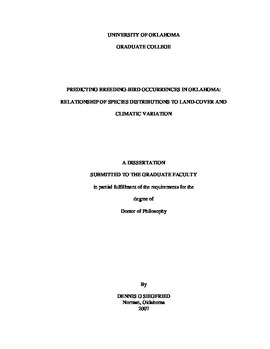| dc.contributor.advisor | Schnell, Gary D., | en_US |
| dc.contributor.author | Siegfried, Dennis G. | en_US |
| dc.date.accessioned | 2013-08-16T12:20:38Z | |
| dc.date.available | 2013-08-16T12:20:38Z | |
| dc.date.issued | 2007 | en_US |
| dc.identifier.uri | https://hdl.handle.net/11244/1183 | |
| dc.description.abstract | Predictive modeling for species distributions has received considerable attention in the past decade. As more data sets and better satellite images become available it is of interest to know how well modeling techniques can use environmental variables in predictive models of species distributions. I evaluated: how well logistic regression develops predictive models for distributions of the 209 species of the Oklahoma breeding-bird-atlas project; the number of sites needed by logistic regression to develop robust models; how well logistic regression and GARP (genetic algorithm rule-set prediction) predicted species distributions; and how well logistic regression and GARP predicted species richness. | en_US |
| dc.description.abstract | Predictive models for species distributions were developed using logistic regression with 13 land-cover and 21 climatic variables. The 209 species models were then applied to the 562 breeding-bird-atlas sites and 12 independent sites surveyed in 2004. Models correctly predicted occurrences 89.4% of the time for the 562 sites and 81.8% for the 12 sites. Greater species richness was found at sites with more land-cover types and was positively associated with principal component 1 for climatic variables. | en_US |
| dc.description.abstract | It is of practical interest to know the amount of data required to produce reliable models. I developed nine training sets of from 50 to 450 sites for each species to predict occurrence in a 100-site test set. Model performance was determined by the reduction in error of prediction (tau-p) compared to the null. On average, model performance leveled off after 300 sites. | en_US |
| dc.description.abstract | It is of interest to evaluate abilities of techniques to predict species occurrences and species richness. I compared logistic regression and two forms of GARP in predicting individual species distributions. Logistic regression produced more consistent results, while GARP overpredicted presences. When distribution predictions were summed to estimate species richness for a given site, logistic regression was a better predictor of species richness than GARP, but it did not produce particularly reliable relative measures across sites. GARP routinely overpredicted species richness per site and also did not produce reliable relative measures across sites. | en_US |
| dc.format.extent | x, 108 leaves : | en_US |
| dc.subject | Birds Geographical distribution. | en_US |
| dc.subject | Biology, Ecology. | en_US |
| dc.subject | Biology, Biostatistics. | en_US |
| dc.subject | Birds Oklahoma. | en_US |
| dc.title | Predicting breeding-bird occurrences in Oklahoma: Relationship of species distributions to land-cover and climatic variation. | en_US |
| dc.type | Thesis | en_US |
| dc.thesis.degree | Ph.D. | en_US |
| dc.thesis.degreeDiscipline | Department of Biology | en_US |
| dc.note | Source: Dissertation Abstracts International, Volume: 68-04, Section: B, page: 2038. | en_US |
| dc.note | Adviser: Gary D. Schnell. | en_US |
| ou.identifier | (UMI)AAI3261106 | en_US |
| ou.group | College of Arts and Sciences::Department of Biology | |
